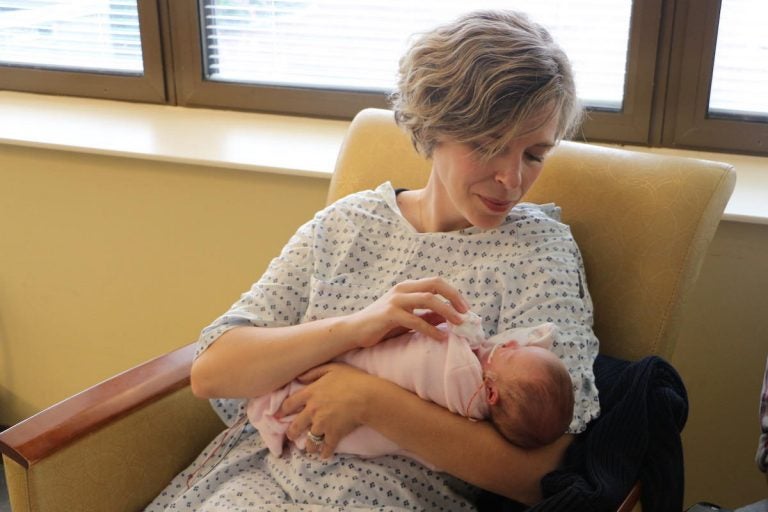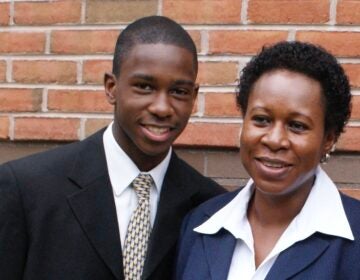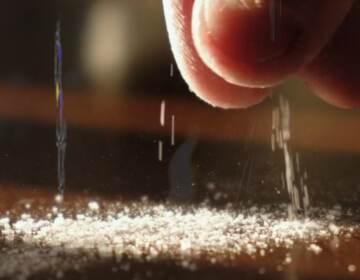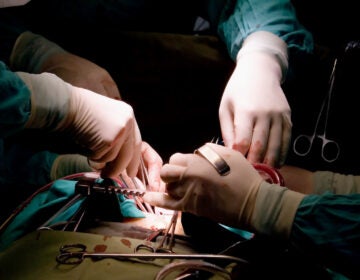Feeding your baby another woman’s milk
Humans have a long history of sharing breast milk, but society’s acceptance has ebbed and flowed.
Listen 0:00
Jaime Martin holds her daughter, Ruby. She's 11 weeks old but was born so early that doctors still refer to her by her gestational age. (Emily Siner/WPLN)
As soon as a baby is born, one of the first big decisions parents have to make is what to feed their newborn.
Formula? Breast milk? In recent years, breast milk has become an increasingly popular ‘doctor recommended’ choice — but some moms and babies can’t make that work.
Jaime Martin’s daughter, Ruby, was born three and a half months early and spent her early days in the neonatal intensive care unit (NICU).
“She had very red, almost gelatinous skin,” Martin says. “And really, really tiny. [My husband’s] wedding ring went around her arm.”
On top of all that, Martin couldn’t produce breast milk. This was not entirely a surprise; a decade and a half ago, she had gotten a breast reduction.
“They had to take everything apart, and the likelihood of you being able to breastfeed, as they told me at 23, was going to be highly unlikely.”
At the time, she thought it wouldn’t be an issue. If she had children one day, she’d just put them on formula.
But once she had a tiny, pre-term baby, it did become problem. Premature infants are at a high risk of a disease called necrotizing enterocolitis, or NEC. It devastates their intestines and is often fatal.
“NEC is the bane of our existence here in the NICU,” says Joann Romano-Keeler, a neonatologist with Pediatrix Medical Group of Tennessee. “And, in all of the years of research that’s been done, including some of the research that I’ve done myself, the only protective factor that we’ve discovered for NEC is breast milk.”
So now, when a mom can’t produce enough, many hospitals rely on breast milk banks. Like blood banks, these are nonprofits that screen their donors — in this case, moms with extra milk — for HIV risk or illegal drug use. The bank then pasteurizes the milk and sells it primarily to NICUs, to feed sick babies like Ruby.
The scientific research around using breast milk as medicine is relatively new. But sharing milk is quite the opposite, according Maryanne Perrin, a nutritionist and researcher at the University of North Carolina at Greensboro.
“If you ask the anthropologist, it’s always been a thing, right? I mean, it’s how our species survived,” she says.
For millennia, if one mother wasn’t able to feed her child, another would help out and nurse the baby. There’s evidence of wet nursing being a profession as early as 2000 B.C. Wet nurses are mentioned in the Old Testament and in the The Code of Hammurabi, a set of laws written in ancient Mesopotamia.
During the Renaissance period in France, wet nursing was a registered profession, and women were typically paid well. By that time, the decision to hire someone to nurse your child was often about choice, aesthetics, and convenience — not just necessity.
After the baby bottle was modernized in the 1800s, wet nursing basically went away. Milk sharing banks popped up in the early 1900s, but most of those disappeared during the HIV epidemic in the 1980s.
But Perrin says milk banks have started catching on again in recent years as there’s been more research about the benefits of breast milk.
“In 2013, when I started my dissertation work and looking at milk banking practices, I think there were 12 or 13 operating milk banks in North America,” she says. “Today there are 26. So that’s doubled in four years.”
Even more common in the United States are mothers who share milk with each other outside of a formal organization. One mom can’t produce enough, another has extra, and they find each other. There are entire Facebook groups devoted to this practice.
Ashley Glenn decided to donate after she gave birth a few years ago. Glenn is the co-owner of Bosom Buddy, a lactation counseling service, and was working from home at the time, so she was able to pump extra milk. Then she saw a post on social media from a woman who had just adopted a son.
“She ended up with 100-and-something donors, but every single thing he had from zero to 12 months was breast milk,” Glenn says.
But not all mothers — even those who breastfeed — are comfortable with the idea of milk sharing. LaShonda Watson-Brigham, a Nashville mom was watching her 8-year-old play on the playground, says it seems strange to her.
“I breastfed both of my kids, and it’s real personal and intimate,” she says. “So I wouldn’t necessarily want someone else’s.”
Also at the playground, Jennifer Johnston pushes her daughter in a swing set. She says it just seems too risky.
“You just never know what women do to their bodies. You never know what drugs they’re taking. You never know what lifestyle they have,” she says.
She’s not alone in this concern. The U.S. Food and Drug Administration recommends against sharing breast milk without proper screening for infectious diseases or contamination. But advocates of peer-to-peer milk sharing push back on that: they say moms ask each other about diet or medications first — so they trust each other.
This also makes Sabrina Box, a mother of four, wary. She says, why bother taking a risk with someone else’s breast milk when you can just feed your kids formula, like she did? But then, a few minutes later, she remembers a friend’s Instagram post offering extra milk.
“She posted the picture of the whole freezer door full. And I thought, actually, at the moment … I know what a healthy, wholesome person she is. I would like that milk!” Box says. “If I had a baby, I’d be like, ‘Give me some of that.’ ”
Although infants have just a few food options compared to the rest of us, deciding what to feed them is incredibly personal. Often the choice depends on what a parent’s friends are doing. It’s a whole different story if their baby is in the NICU. Where you decide to stand on the breast milk to formula spectrum can feel highly charged— even political.
But Ashley Glenn, the lactation counselor, has noticed an overall cultural shift with milk sharing in the past few years.
“It has become more mainstream. You aren’t thought of as the crunchy hippie sharing the milk,” she says. “The everyday mom has a friend who breastfeeds who has extra milk. And it’s no longer looked at as, ‘Oh gross, you’re doing that.’ Now it’s just the norm.”
WHYY is your source for fact-based, in-depth journalism and information. As a nonprofit organization, we rely on financial support from readers like you. Please give today.






